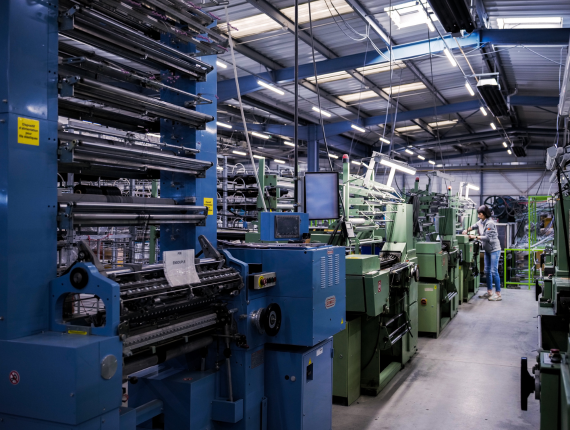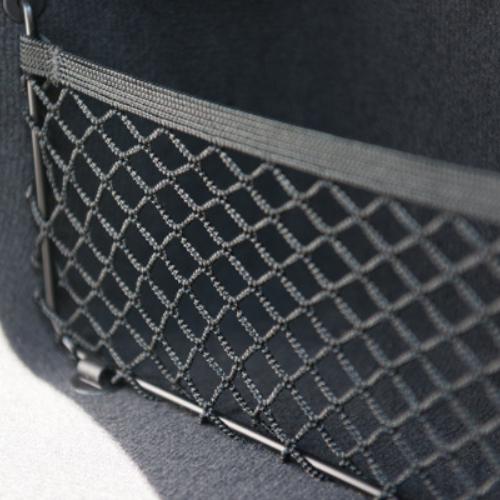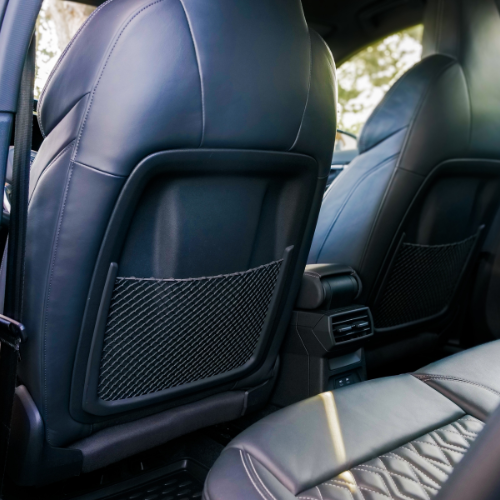In the car industry, every detail counts when it comes to providing users with optimal comfort inside vehicles. Seat storage nets, installed at the back or sides of seats, offer a simple, discreet, and effective solution for optimizing space while securing objects whilst driving.
Eurosandow designed its first net in 1995 for the new Citroën Saxo. This was a major milestone in the company’s history, which, 30 years later, continues to produce nets for models from the world’s leading car manufacturers.
Thanks to our textile expertise, high-performance machinery, and in-depth knowledge of industry requirements, we offer reliable, durable products that meet the most stringent specifications.
Whether you are an equipment manufacturer or a vehicle manufacturer, we support you in developing textile solutions tailored to your vehicle platforms.
What are the different types of seat nets available on the market?
Today, vehicles incorporate various features to optimize comfort in the passenger compartment. There are several models of nets that can be attached to car seats.
Rear seat net pocket
Attached to the back of the driver’s or passenger’s seat, the storage net is one of the most common storage solutions. It allows rear passengers to easily store everyday items such as magazines, bottles, a tablet, a first aid kit, etc.
Footwell net
Placed inside the doors, on the back of the seats, or on the side panels, footwell nets allow you to quickly stow small items such as a smartphone, documents, or a charger.
Envelope storage nets
Attached to the back of the rear seats and accessible from the trunk, this type of net is particularly useful for securing items in the cargo area. It can be used to secure bags, organize groceries, sports equipment, or tools, while limiting movement while driving.
Footwell nets
This net is positioned at floor level, between two rear or front seats, to make use of the space that is generally unused in the area known as the “footwell.” It allows small items to be stored within easy reach.
What criteria should be considered when choosing a car seat net?
The choice of a car seat net should not be left to chance. It is a functional accessory that contributes to the organization and comfort of the passenger compartment, while blending in with the interior design of the vehicle. To ensure a perfectly tailored solution, several technical criteria must be taken into account:
Rigid or elastic net
Dimensions of an automotive net
Which materials should you choose?
What kind of frame?
What types of fasteners are used for a car seat net?
What color options are available?
The degree of elasticity of a net depends directly on its end use. An envelope net, for example, is generally designed with an elastic structure in order to adapt to objects of various shapes and sizes, such as bags, toolboxes, or sports equipment.
The elasticity of the product can be adjusted according to the customer’s specifications to ensure optimal integration into the interior design.
The dimensions of the net will depend on the use of the product and the configuration of the vehicle’s seats.
The dimensions of a car seat net vary depending on its location, function, and the specific features of the vehicle. There is no universal size: each model is designed to meet a specific need in the passenger compartment. For example, a “footwell” type net may measure around 150 x 350 mm, while a wrap-around net may measure up to 440 x 730 mm. The pocket net, positioned behind the front seats, can measure 190 x 330 mm. These sizes are given as a guide and do not represent a standard. We adapt the dimensions of each net according to the specifications so that they fit perfectly with the seat configuration and interior design constraints.
We are able to manufacture nets ranging in width from 10 to 4000 mm, with no restrictions on length. This adaptability allows us to offer solutions that perfectly meet the technical constraints of each project.
The choice of materials used for a net depends on its mechanical, aesthetic, and environmental constraints. Among the most commonly used are:
- Polypropylene: lightweight, resistant to moisture and chemicals, it is ideal for the automotive industry.
- Polyester: very robust, it offers excellent durability over time, even under heavy mechanical stress.
- Cotton: less common in the automotive industry, it is appreciated for its natural feel and textile appearance, often used in specific or decorative applications.
- Polyamide (nylon): known for its high elasticity and abrasion resistance, it is well suited to products subject to frequent deformation.
- Natural latex: used as the core yarn in elastic cables, it provides optimal elasticity and good tension retention in the net.
Each material has specific advantages that are taken into account according to the technical, aesthetic, and economic requirements of the project.
One of the key elements in integrating a net into a car seat is the choice of frame on which it will be mounted. This frame structures the net, influences its strength and performance in use, and contributes to the final aesthetic appearance. Depending on the location of the net in the vehicle (front seat backrest, trunk, footwell, etc.) and the desired interior design, several types of frames can be considered.
The plastic-coated metal frame is a robust and proven solution, widely used for storage nets behind the front seats. Covered with a plastic coating, it offers excellent resistance to impact, wear, and corrosion, while ensuring a neat finish.
In the same vein, there are also plastic-coated steel frames, which offer enhanced strength.
Various materials can be used to make the frame, such as polyethylene, POM, polypropylene, or polyamide (with or without reinforcement).
Finally, some net models are designed with a flexible woven strap frame, offering a lightweight and flexible alternative.
The choice of fastening system for a car seat net depends mainly on its location, use, and the specific constraints of the project. Several solutions are possible, ranging from standardized options to fully customized systems.
Among the most common fasteners are hooks with different finishes (plastic-coated, metal, etc.), carabiners, and elastic cable loops. Custom fasteners can also be designed according to customer specifications and requirements.
This type of fastener makes it easy to attach the net to the back of the seats.
For nets mounted on metal frames, plastic fastening clips are generally used to attach the nets to the car seats.
To securely attach nets equipped with frames, equipment manufacturers use a technique called heat sealing. This involves applying a heated mold that partially melts the plastic, ensuring that the net is permanently attached to the seat structure. This process creates a permanent bond: once attached, the net cannot be removed from the seat, ensuring a durable and robust hold.
While black remains the most commonly used color for seat nets due to its discretion and versatility, it is entirely possible to customize the color of the product to suit the aesthetic requirements of your project.
At Eurosandow, we design custom nets based on your specifications. Thanks to our expertise in weaving and knitting, we can offer plain or multicolored nets by varying the threads or textile straps used.
A striking example: we developed a net using orange straps for the very first Renault Captur model. This bold color choice, integrated directly into the vehicle’s design, perfectly illustrates our ability to adapt our products to the aesthetic requirements of manufacturers.
How are our automotive seat nets manufactured?
We offer both a range of standard nets, available in our catalog, and custom solutions, designed specifically to meet the requirements of each project.
Our R&D department supports our customers in developing customized products based on their specifications. This expertise allows us to meet a wide range of needs.
With a fleet of 12 knitting machines and 12 weaving machines, we manufacture a wide range of nets: rigid or elastic, single or double-sided. This production capacity allows us to meet a multitude of applications.
The manufacturing, cutting, sewing, and welding operations are carried out in our workshops in Saint-Étienne. This in-house expertise guarantees perfect traceability and consistent quality.
Our nets undergo rigorous testing and are designed to meet the strict standards of the automotive industry.






